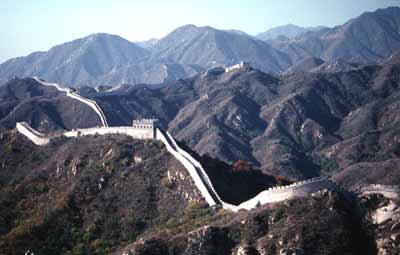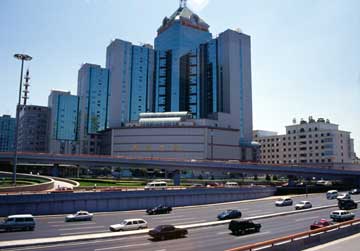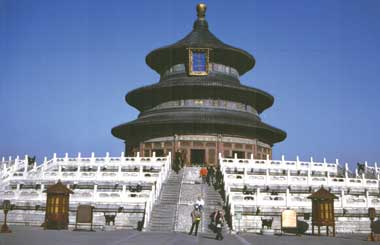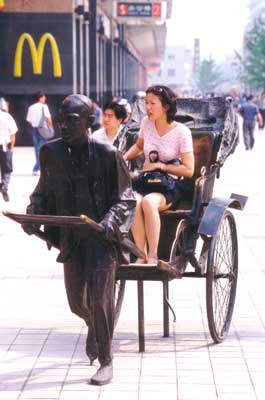| A Five-Day Adventure in Beijing |
| http://www.sina.com.cn 2004/04/20 07:06 中国周刊 |
I am frequently asked "What do you do all day in Beijing?" Apart from writing I explore the city on foot in an attempt to keep up-to-date with what is happening here. Every day reveals new sights, gives new experiences and provides more happy memories of life with the ordinary people. This ancient capital city is changing so fast that once familiar places disappear while new ones emerge. Thankfully the great historical buildings remain for posterity. What is rapidly emerging is a fast moving international city of the 21st century. Any visitor coming here, particularly for the first time, should try to include a look at the way Beijing, and indeed China, is going. After all we are entering a critical phase for the country's position in the world as its rapid economic growth puts it increasingly into the position of being a major player on the global stage.
In many ways what tourists see in their guided tours around Beijing is a China of the past, but that is often what visitors want to see, their dream of the splendours of this great land. Yes, the Imperial palaces are part of the country's legacy and are important reminders of the majesty of Chinese architecture and should not be missed. Similarly the old residential hutong alleys are a delight to wander through - a chance to drift into a world rapidly disappearing. However the stage where China's 21st century action is rapidly being played out is found in outlying districts such as Zhongguancun and Chaoyang. What is rapidly emerging in urban China today is an accelerating international lifestyle. Beijing, for example, is now a city of eating, drinking and entertainment round the clock. Many of the its venues rank as places to be seen in - a far contrast to a few years ago when everything seemed to close at 9.00pm and restaurants served mostly the same local food. Culinary experiences today include the opportunity to try a diverse variety of ethnic and regional foods from all over the country. Dinner, for example, in a Xinjiang restaurant (from Northwest China) is a totally different experience to that in the Guangdong restaurants specializing in seafood brought from the South China Sea. These days the city also has a broad international theme to it with not only many popular Korean and Japanese establishments but also Indian, Mexican, Italian and so many more. First time visitors coming here for five days are going to be tight for time, so early starts are inevitable, but how to work these in with experiencing Beijing's nightlife? Many times I have been invited to introduce the city to newcomers, whether arriving as visitors or coming here to work.. Soon I will also have to organize a comprehensive package for a group of impressionable high school students from Scotland. Start with Tian'anmen
Usually I start with Tian'anmen Square because the Square represents the spiritual heart of not just Beijing but also of China. Anyone who can arrive at sunrise or sunset and witness the Flag Raising or Lowering Ceremony will quickly come to realize the importance of the Square to the Chinese people. There is so much more to see such as the Tian'anmen Gate where Mao Zedong brought in the People's Republic of China on 1 October 1949. The Gate is also a reminder of Imperial Beijing when it marked the entrance to the Forbidden City. However the Square is about China's revolutionary struggle and contains many fascinating reminders such as the Monument to the People's Heroes and the socialist-realism statues of fighters and liberators around the Mao Zedong Mausoleum. To understand more of the Revolution time should be spent in the Museum of Chinese Revolutionary History before crossing the Square to walk through the vast chambers of the Great Hall of the People. The size of the main assembly hall and the great dining room are breathtaking testimonies to the size of this country. The southern end of the Square also has interest with the proud Qianmen Gate marking the end of the Imperial City and the continuation south of the axis around which historic Beijing was laid out. To the east is the former foreign legation district, a testimony to Western influence in the latter days of the Qing Dynasty (1644-1911). Buildings in this quarter, grand in style, convey a sense of European architecture. One is now home to the fascinating Beijing Police Museum. South of Qianmen is the original commercial district of the Imperial City, Dashalar. A wander around its narrow streets with historic teahouses; pharmacies which served the emperors and shoe shops that supplied footwear for Mao Zedong and other great leaders are great for browsing and experiencing bustling street life. An entire day could easily be spent in the Tiananmen/Qianmen area. The area is also packed with restaurants; some providing views over the Square while others offer the opportunity to appreciate Beijing Opera while drinking tea and nibbling on local snacks.
Historic Beijing is built around the Forbidden City, the former royal residence. This distinguishes it from other Chinese cities and the presence of the Palace has also previously determined architectural height and building style within the bounds of Number 2 Ring Road (erhuan) that today marks the line of the former city walls. No buildings could be higher than the palace walls and the homes of ordinary citizens had to be a nondescript grey colour. First-time visitors should visit the Palace but before doing so should walk up the artificial hill at Jingshan Park. This allows a stunning view over the Forbidden City and also allows an appreciation of the north-south axis line running 8 kilometres from the Bell and Drum Towers (Zhonggulou) south through Tian'anmen to Yongdingmen. The unique pattern of the palace can clearly be seen with buildings east and west of the line being images of each other, or in harmonious balance. Obviously exploring the Palace, one of the World's historic wonders, is a 'must see' attraction. Starting from the southern Tian'anmen Gate t is worth continuing through the North Gate (beimen) and across to the Beihai Park. Built around a great lake (the North Sea), this formerly was a garden for the emperor's contemplation and study. Sections contain water and stone in the combination found in the Yangzi Delta around the historic city of Suzhou. Going north beyond the park is the new pleasure grounds of Beijing, the Shichahai Lake area with its combination of former royal residences, one-story courtyard homes, marble bridges and very pleasant courtyard bars. It is a place to relax while watching fun on the lakes combined with the continual passage of pedicab carrying enthralled tourists. One day's exploration into Hutong
Beijing's hutong, the traditional courtyard homes ('siheyuans') of the historic city, are one of the delights for a day's exploration. Although many hutongs have been cleared in the name of urban improvement extensive remaining areas still exist close to the Shichahai Lake area. Features to be looked out for include the grey tiled roofs, which sometimes combine intricate design and the structure of each doorway. The size of the door, the wider and more recessed and the greater the mass of the carved stone piers immediately outside all are testimony to the position and wealth of the former residents. Most of the original inhabitants had been civil servants and officials within the Imperial Court. A fascinating historical walk through some of Beijing's best hutongs starts from the city's magnificent Lama Temple (yonghegong), continues along Guozijian (Imperial Street) past the Confucius Temple and College and extends across Andingmen Nei Dajie to the Gulou District. The choice of temples Of course, when we mention temples, it is important to visit one of the finest in China, the Temple of Heaven (tiantan). This was one of the most important sacrificial sites in the historic city. Others, now all parks, include Ditan (Earth Altar), Ritan (Sun Altar) and Longtan (Dragon Altar). If visiting the Temple of Heaven at the weekend it is worth jumping in a taxi and visiting Beijing's great antique market Panjiayuan near the southeast section of Number 3 Ring Road. Exploring Beijing's connections with the past could involve a visit by metro and bus to the scenic Fragrant Hills (xiangshan) Park on the western edge of the city. Formerly private hunting grounds for the emperors, the park contains the unique Azure Clouds Temple with its Indian-style principal building. On a clear day the view from 'Incense Burner Peak' is stunning - behind stretch ranges of jagged mountains while beyond the hills stretches the broad plain holding the city seemingly stretching as far as the eye can see. Not far from the park are the two summer palaces with their lakes and gardens. Both are testimony to the excesses of the Imperial families and sadly the wanton 19th century destruction by forces of the foreign legations based in the city. They can be reached by boat along the canals from Yuyuantan Park, behind CCTV's principal studios. Look out also for the CCTV Tower. The views directly below show a modern city of futuristic architecture and an advanced expressway system. Take in a glimpse of new China Any visit to this area should try to take in a glimpse of new China. Close to the Summer Palace lies both Pejing and Tsinghua universities - top national seats of learning. Around them science parks are growing in an area known as Zhongguancun, often referred to as China's 'Silicon Valley'. Here some of the nation's IT future is being mapped out and stores are filled with the latest computers and ancillary devices. It seems a world away from the historical palaces. There are many scenic spots on the outskirts of the city. Several sections of the Great Wall offer different attractions for visitors. One is the Mutianyu section - not only is the Wall spectacular as it rises over jagged mountains but in the valleys are many new hotels and holiday developments based around outdoor adventure and eating countryside food including delicious fish caught fresh from the river. The suburbs contain a wealth of attractions for anyone with sufficient time. The Ethnic Nationalities Park north of Number 4 Ring Road allows those with limited time to experience the lifestyle and building design of China's many ethnic groups living mostly in the country's extremities. Another amazing park is the World Scenic Park at Fengtai where it is possible to visit Australia, Britain, Egypt and many other countries with their prominent attractions without leaving Beijing! Shopping day Of course, no visit is complete without shopping. You'd better go to shops to see how China is changing than Wangfujing Street. The premier city centre shopping street, it has undergone extensive environmental upgrading, pedestrianisation and introduction of a wealth of new facilities. It is a sign of the way the country is going and a place to watch the modern lifestyles of the city's up-and-coming young population. The shopping malls, such as the recently opened Oriental Plaza; Sun Dong An and the refurbished Beijing Department Store illustrate a highly developed consumer market and are also great places to eat - cheaply! Incidentally, hidden behind Wangfujing are amazing snack food streets capturing historical and regional eating habits from throughout China. Wangfujing also illustrates some of the environmental improvements underway in the city with pedestrianised streets, landscaped gardens and the increasing number of metal sculptures appearing throughout the city centre. The street is also home to the beautifully restored St Joseph's Cathedral - a reminder of the city's history in the midst of modernity! Nearby also is the recently restored Nanchizi District, capturing the architectural spirit of Old Beijing. It adjoins the lovely Changpu He Park, opened last year and created in an area of formerly rundown buildings. Food has to be one of the memories any visitor should leave with. A week's stay in the nation's capital should try to take in the breadth of experiences now on offer. Try the Yunnan food offered in the Dai Village Restaurants, or the Moslem Uigher food found in the Xinjiang restaurants where brightly costumed girls will actually dance on your table while you dine, or the spicy Sichuan hotpot - there is enough variety in the city that one year would not be enough to try out every restaurant or dining style. Later in the evening, for a bit of homely nostalgia, it is possible to retire to a British, German or Irish pub and wonder if you are really in China. Yes, but it is 21st century international China! Quite simply Beijing has so much to offer that one visit means many returns to try to experience all that the city can provide. That of course is impossible because it is changing so fast that every day new and more exciting attractions are opening. Text and photos by BRUCE CONNOLLY |
| 【英语学习论坛】【评论】【大 中 小】【打印】【关闭】 |



